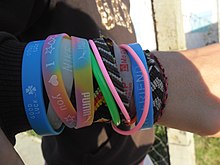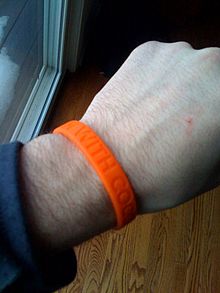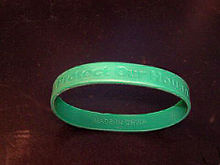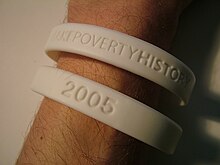
with braided bracelets
and woven bracelets
Gel bracelets (or jelly bracelets) are a type of wristband often made from silicone.
Gel bracelets
Gel bracelets usually have a rectangular or circular cross-section. They are stretchy and come in a variety of colors. They have been popular in waves throughout the Western world and elsewhere since the 1980s.
Charity awareness wristbands

Awareness bracelet wristbands carry messages demonstrating the wearer's support of a cause or charitable organization. The silicone wristband first became popular in 2004 with the Livestrong yellow band which was set up by American cyclist Lance Armstrong to raise awareness of cancer. Subsequently, a larger, 1-inch (25 mm) wide variety became more popular in 2007, with musical groups selling them to young concert fans.
The wristbands are often seen by young people as trendier than traditional charity pins. The wristbands have also become a popular tool used in fundraising, as both the wider and thinner bands are cheap to custom manufacture. The price of these wristbands varies depending on the particular campaign but is often $1 or £1, and the majority of the money usually goes towards the charity or cause involved.
Urban legend of sex bracelets
See also: Handkerchief codeDuring a resurgence in popularity in 2003, gel bracelets became the subject of a widespread urban legend linking them to a supposed sex game, explaining their popularity among young teenagers. They were subsequently dubbed "sex bracelets". According to rumors, people who wore the jewelry implied they were willing to engage in various acts with whoever pulled them from their wrists. The acts ranged from hugging to kissing to sexual intercourse and were determined by the bracelet's color.
In October 2003, the rumors were prominent enough in Alachua Elementary School in Gainesville, Florida that the principal banned the bracelets to avert disruption and inappropriate comments about them. They were subsequently banned in other schools in Florida and elsewhere. The effectors of these early bans did not insinuate that the rumors were true; however, some later media reports suggested that they may have been generating a moral panic. The British press reported on the supposed meanings of the band's colors in 2005.

Similar stories surfaced in the British media in 2009, in which the bracelets were allegedly nicknamed shag bands. Similar stories circulated widely in Brazil during the 2009/2010 summer, where the bracelets were referred to as pulseiras do sexo. In March 2010, a 13-year-old girl in Brazil was raped by three teenage boys after one of them snatched the bracelet she was wearing. The police stated that the crime was motivated by the use of sex bracelets.
Different versions of the legend associate different colors with sexual acts (similar to the handkerchief code). For example, purple might be associated with kissing, red with lap dancing, and black with intercourse. Some versions say the sexual activity occurred at parties held for the purpose, making them similar to contemporary rumors of "rainbow parties", a gathering where girls wearing varying shades of lipstick supposedly take turns fellating their male counterparts, leaving an array of colors on their penises. Other tales of teenage sex parties have circulated at various times. Folklorist Barbara Mikkelson of snopes.com associates the "sex bracelet" stories with similar ones of the past. In the 1970s, pull tabs from aluminum cans and labels from beer bottles were supposedly considered "sex coupons" and obligated any girl presented with one to sleep with the bearer. By the 1990s, the rumors shifted to include an assortment of plastic items, including some worn as bracelets. According to Mikkelson, there is likely little truth behind the stories, and the vast majority of teenagers who contact her site express shock and disappointment that so many have believed them.

At least one type of gel bracelet called the MY Single Band was specifically designed to advertise the wearer's relationship status. The response to this bracelet was largely critical, with Natasha Burton of Cosmopolitan saying she doubted men would look for such a bracelet given that she was still approached even while wearing her engagement ring. The staff of Glamour were reportedly uncomfortable with the concept, and Eliana Dockterman of Time magazine even compared it to wearing one's OkCupid profile on their T-shirt.
See also
- Awareness ribbon – developed from 1917 through 1986 to symbolize remembrance of service members and other causes
- Gospel bracelet
- Lockets and eye miniatures – mementos of loved ones c. 1785
- Lock of hair – memento dating to of an American serviceman captured or missing during the Vietnam War
- Wrist-band.com – American technology company
References
- Wristband Resources (September 30, 2022). "Solid Silicone Wristbands". Archived from the original on September 30, 2022. Retrieved September 30, 2022.
- ^ Mikkelson, Barbara (2003). "Sex Bracelets" Archived 2020-01-22 at the Wayback Machine. snopes.com. Retrieved December 22, 2005.
- "What are wristbands about?" Archived 2005-09-12 at the Wayback Machine (February 01, 2005). news.bbc.co.uk. Retrieved December 2, 2006.
- Vande Bundt, Mark (10 December 2005). "Faith strong ; Christians co-opt culture to wear beliefs on sleeves". The Grand Rapids Press. ProQuest 286065397.
- Walker, Rob (2004-08-29). "THE WAY WE LIVE NOW: 8-29-04: CONSUMED; Yellow Fever". The New York Times. Archived from the original on 2020-11-18. Retrieved 2020-01-31.
- "Charity wristband trend". British Council - Poland. Archived from the original on 2007-11-20. Retrieved 2020-01-31.
- Mulligan, Sean (9 September 2015). "Gel Wristbands Explained". Wristband Bros. Sean Mulligan. Archived from the original on 4 March 2016. Retrieved 9 September 2015.
- Aguilar, Alexa; Bell, Kaitlin (November 18, 2003). "Rumors Link Bracelets to Sex Game". St. Louis Post-Dispatch.
- "Sex bracelets:are they for real?". TODAY.com. 10 December 2003. Archived from the original on 2020-09-14. Retrieved 2020-01-30.
- ^ "Student 'sex bracelets' an urban legend?". CNN. CHICAGO, Illinois. December 12, 2003. Archived from the original on December 20, 2003. Retrieved February 10, 2006.
- James, Douane (October 18, 2003). "Principal puts ban on 'sex bracelets'". The Gainesville Sun. Archived from the original on 2007-03-07. Retrieved September 30, 2006.
- ^ "'Sex Bracelets' Cause Parental Concern". NBC 10. RALEIGH, N.C. November 20, 2003. Archived from the original on February 11, 2008. Retrieved September 30, 2006.
- Belkin, Lisa (2009-09-14). "Are Colored Bracelets a Code for Sex?". Archived from the original on 2019-10-01. Retrieved 2020-01-30.
- Pook, Sally (March 25, 2005). "Blair joins wristband celebrities who make charity cool". The Daily Telegraph. London. Archived from the original on July 6, 2016. Retrieved April 3, 2018.
- Jayson, Seth (2007-10-03). "Countrywide's Misguided Pride". The Motley Fool. Archived from the original on 2015-05-04. Retrieved 2013-09-12.
- "'Protect Our House' Wristband Campaign Shows the Worst of Corporate America". Best Cash Cow. October 3, 2007. Archived from the original on October 13, 2007. Retrieved March 15, 2021.
- Stretch, Euan (25 Sep 2009). "Fury over 'sex' bracelets sold to school children". Daily Mirror. mirror.co.uk. Archived from the original on 23 October 2012. Retrieved 25 Oct 2009.
- Midgley, Carol (10 Nov 2009). "Would you let your daughter wear a "shag band"?". The Times. London. Archived from the original on 15 June 2011. Retrieved 10 Nov 2009.
- Paulo Toledo Piza (13 December 2009). "'Pulseira do sexo' gera polêmica entre pais e educadores em SP" ['Sex bracelets' generates controversy among parents and educators in São Paulo] (in Portuguese). Archived from the original on 6 January 2011. Retrieved 7 February 2012.
- Araújo, Glauco (31 March 2010). "Após ter 'pulseira do sexo' arrancada, adolescente é estuprada em Londrina" [After having 'sex bracelet' ripped off, teenager is raped in Londrina] (in Portuguese). Archived from the original on 19 January 2021. Retrieved March 15, 2021.
- Frosch, Dan (2009-09-12). "School Bans Bracelet Used in Sex Game". The New York Times. Archived from the original on 2021-01-26. Retrieved 2020-01-30.
- Taylor, Victoria (22 August 2013). "Will bracelets for singles revolutionize dating?". Daily News. Archived from the original on 27 August 2013. Retrieved 1 September 2013.
- ^ Dockterman, Eliana (1 September 2013). "MY Single Band: A Bracelet That Advertises You're Single". Time. Retrieved 1 September 2013.
- Burton, Natasha (20 August 2013). "Would You Wear a Bracelet That Tells Guys You're Single?". Cosmopolitan. Archived from the original on 2 August 2014. Retrieved 1 September 2013.
- Hannah Lyons Powell (20 August 2013). "My Single Band: Will you be wearing your heart on your wrist?". Glamour. Archived from the original on 23 August 2013. Retrieved 1 September 2013.
External links
| Sexual urban legends | |
|---|---|